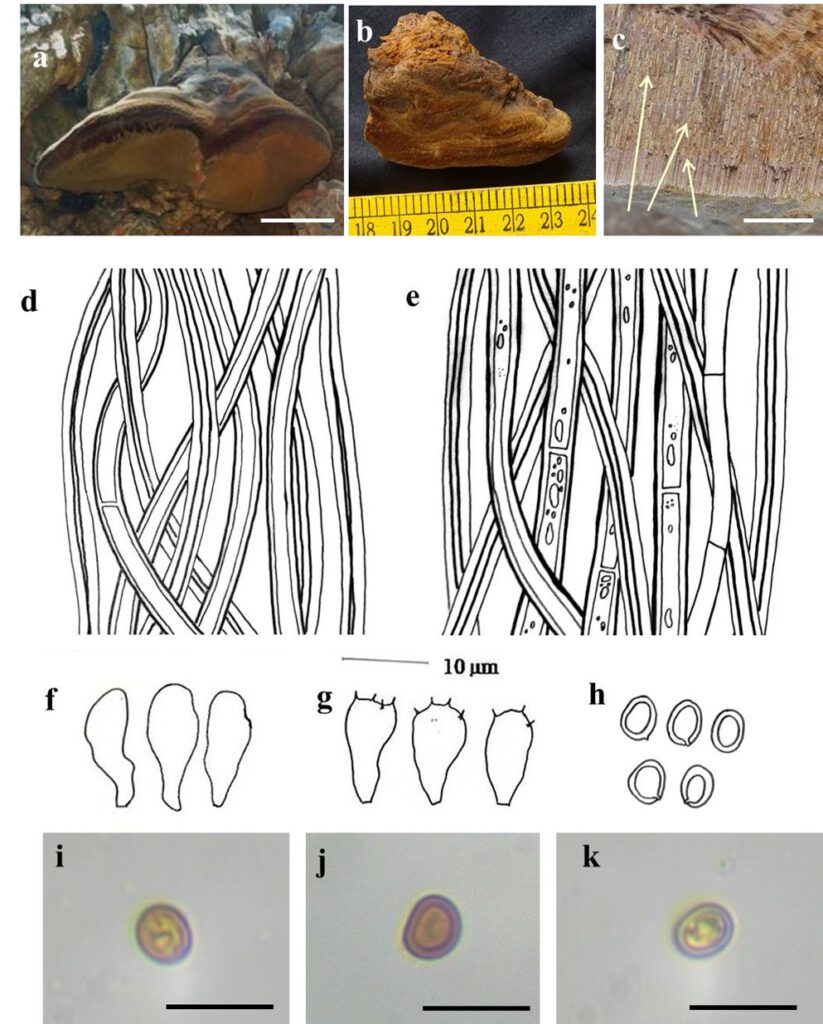Fulvifomes malaiyanurensis Gunaseelan, S., Kezo, K. & Kaliyaperumal, M., sp. nov.
MycoBank number: MB 821517; Index Fungorum number: IF 821517; Facesoffungi number: FoF 10744; Fig. 2
Etymology: The species epithet “malaiyanurensis” referring to the locality of basidiomata collection.
Holotype: CAL 1618
Description: Basidiocarps perennial, solitary, sessile, broadly attached to substrate, hard, light when dry. Pilei dimidiate, ungulate to triquetrous, projecting up to 5 cm, 12 cm wide and 4 cm thickness near attachment. Pilear surface velutinate towards margin, partially, concentrically zonate, brown (6E6) to greyish brown (6F3), cracked during collection. Margin obtuse often round, velvety shining, brown (5E8) to yellowish brown (5E4). Pore surface umber-brown (5E8). Pores regular, circular to angular, 5–7 per mm. Dissepiments thick, entire. Context yellowish brown (5C7) to dark golden brown (5C7), woody corky, up to 2 cm thick. Tube layer brown (6D7), up to 2 cm long in distinctly stratified, individual layer up to 0.5 cm in long.
Hyphal system strictly dimitic, skeletal and generative hyphae acyanophilous, tissue darkening with KOH without swelling. Context: Hyphal system subparallel, generative hyphae dominant hyaline to yellow, simple septate, thin to thick walled, 2.2–6.4 μm in dia., rarely septate and branched, skeletal hyphae rare, yellow to brown, thick walled, with a narrow to wide lumen, infrequently septate, unbranched, 1.8–5.2 μm in dia. Trama Hyphae interwoven, color not distinct from context; generative hyphae thin to thick walled, frequently septate 2–5.2 μm wide, skeletal hyphae thick walled, unbranched, aseptate with narrow to wide lumen 2.7–5.2 μm. Hymenial setae, cystidia and cystidioles absent. Basidioles clavate, 5–16 × 3–7 μm. Basidia broadly clavate, with four sterigmata, 7–16 × 5–8 μm. Basidispores broadly ellipsoid to subglobose, smooth, yellow to golden yellow in water, turning golden brown to rust brown in KOH, thick walled, (4.2–) 4.6–5.4 (–5.7) × (3.9–) 4.2 – 4.9 (–5.2) μm, Q = 1.09, (n = 50/2), Q =1.05–1.25, CB ̄, IKI ̄. Chlamydospores globose to sub globose, thick walled, rust brown to reddish brown, 5.7– 12.8 × 5.2–11.6 μm, CB ̄, IKI ̄.
Material examined: INDIA, Tamil Nadu, Vizhupuram district, Malaiyanur, 37º 25’19.1”N 23º 36’33”W, on living angiosperm tree (Tamarindus indica), 25 October 2016, Sugantha Gunaseelan (Holotype, MLCASB020)
Additional specimen examined: INDIA, Tamil Nadu, Vizhupuram district, Malaiyanur, 37º 25’19.1”N 23º 36’33”W, on living angiosperm tree (Tamarindus indica), 25 October 2016, Sugantha Gunaseelan, Kezhocuyi Kezo & Malarvizhi Kaliyaperumal (Isotype, MLCASB021)
GenBank numbers: ITS: MF155651, MF155652 (Isotype, MLCASB021), LSU: MW048883, TEF1-α: MW690925
Notes: F. malaiyanurensis is similar to F. thailandicus (Zhou 2015) by sharing yellowish brown, broadly attached basidiomata, pore, dimitic hyphal and absence of cystidioles. However, F. malaiyanurensis is distinct by having ungulate to triquetrous, yellowish brown, velutinate basidiocarp, acyanophilic subglobose basidiospores, lacking cystidioles. F. malaiyanurensis differs from F. grenadensis (Ryvarden, 2004), F. hainanensis (Zhou, 2014) and F. imbricatus (Zhou, 2015) in pileus character, pore per mm, shape and size of basidiospore. F. malaiyanurensis share similar pileial character with F. robinae (Salvador-Montoya et al. 2018) but differs in hyphal system and basidiospore but shares pores/mm. F. malaiyanurensis shares similarity with F. elaeodendri and F. yoroui in triquetrous up to ungulate basidiomata and pores per mm (Tchoumi et al., 2020; Olou et al. 2019) and differs in other characters. Macroscopically, F. malaiyanurensis may resemble African (Tchoumiet al., 2020), Asian (Zhou, 2014, 2015) and American (Ji et al. 2017) known species but shows variation in other taxonomic characters.

Fig. 2: Fulvifomes malaiyanurensis (CAL 1618, halotype). a & b Basidiocarp. c Stratified tube layer. d Tramal hyphae. e Context hyphae. f Basidioles. g Basidia. h Basidiospore. i Basidiospore in H2O. j Basidiospore in KOH. k Basidiospore in cotton blue. Scale: a = 3 cm. c = 1 cm. d–k = 10 µm.
